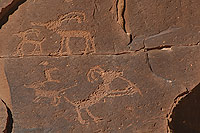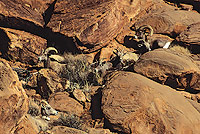Late fall is a great time to look for desert bighorns. This time period represents the annual rut, the time of year when females and their young gather into small bands and males via for breeding rights to the receptive ewes. View these magnificent creatures from a safe distance and take care not to disturb the herd.

Desert bighorns have been roaming the region for thousands of years. Depictions of these animals in Native American rock art panels indicates their importance to these cultures. The animals were hunted for their meat and hides, and bones and horns were processed to make various tools.
Early explorers into the region estimated bighorn populations at over 2 million animals throughout the Southwest. Westward expansion decimated these herds whether through trophy or subsistence hunting or from diseases introduced by domestic sheep. By the mid-1970s, Utah’s wild sheep population was about 1,000 animals.
Relocation programs coordinated between the Utah Division of Wildlife Resources, National Park Service, and others were initiated in the 1980s to build up populations in the Canyonlands region. Sheep were trapped and transported from the Island in the Sky District to Arches National Park to augment the small herd in the park. Other relocation efforts brought sheep to Glen Canyon National Recreation Area, Capitol Reef National Park, and the San Rafael Swell. Captured animals were given health exams by veterinarians prior to transport.
Though these animals inhabit rough terrain such as talus slopes and cliff areas, they gather for the fall rut in more open terrain such as along the White Rim Road in Canyonlands National Park or along Highway 128 as it snakes along the Colorado River. Rams with massive curls via for dominance with each other and breeding hierarchy with the ewes. Close up, the horns, which are hollow sheaths, made of keratin, attached to a boney core called the “horncore.” The horns are permanent, unlike antlers which fall off each year.
Viewing the animals from a distance often reveals interesting behavior during this time, as males filter between ewe groups and their young. The males do a low-stretch behavior where a male lowers his head and stretches forward to “sneer” at other males. If this doesn’t scare away a rival, the rams may also try to kick rivals or chase away younger, less-dominate males. When all else fails, two dominant rams engage in the classic head-butting clash which is an incredible sight to view or hear, as the collision is loud and may echo from the canyon walls.
 Though rival males appear stunned after such a head banging, the foamy bone architecture of their skull and their horns absorb much of the impact. Bighorns have two layers of bone that protect the skull, with boney struts and open cells between the two layers.
Though rival males appear stunned after such a head banging, the foamy bone architecture of their skull and their horns absorb much of the impact. Bighorns have two layers of bone that protect the skull, with boney struts and open cells between the two layers.
When I was a seasonal at Arches National Park in the 1980s, the Park Service, Utah Division of Wildlife Resources, and others, began bighorn capture-and-release programs to establish populations in Arches National Park, and eventually to Capitol Reef National Park and Glen Canyon National Recreation Area. Today, these distinct herds form the nucleus of the population.
Desert bighorns have made a tentative comeback in the Canyonlands region. Their numbers have increased, but still threats from a single disease outbreak from domestic sheep could easily wipe out 80 percent of a herd. Visitors can also help minimize impacts to these creatures by viewing them from a distance and giving the animals space to do their thing, ensuring that future generations will also have the opportunity to view these majestic desert dwellers.